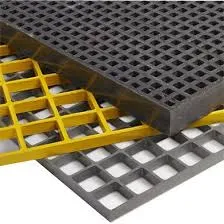loading...
- No. 9, Xingyuan South Street, Dongwaihuan Road, Zaoqiang County, Hengshui, Hebei, China
- admin@zjcomposites.com
- +86 15097380338
- Welcome to visit our website!
Improving Water Management with FRP Drainage Channels for Enhanced Efficiency
Understanding FRP Drain Channels A Comprehensive Overview
In the realm of construction and civil engineering, drainage systems play a pivotal role in managing water flow and preventing structural damage. Among the materials used in drainage solutions, Fiber Reinforced Polymer (FRP) has emerged as a standout option due to its unique properties and benefits. This article delves into the significance of FRP drain channels, discussing their design, advantages, applications, and future prospects.
What are FRP Drain Channels?
FRP drain channels are specialized drainage systems made from fiber-reinforced polymer, a composite material that combines a polymer matrix with fibers—typically glass or carbon. This combination endows FRP drain channels with exceptional strength, durability, and resistance to various environmental factors. Unlike traditional materials such as concrete or metal, FRP is lightweight and has a high strength-to-weight ratio, making it easier to transport and install.
Design Features
The design of FRP drain channels can vary depending on specific applications and requirements. They are often pre-manufactured in various sizes and shapes, enabling customization to fit different landscaping or infrastructural needs. Some designs incorporate features like removable grates or built-in filters to enhance functionality. Moreover, the chemical resistance of FRP allows it to be used in environments where traditional materials might corrode or degrade, such as in agricultural applications or industrial settings.
Advantages of FRP Drain Channels
1. Corrosion Resistance One of the most significant advantages of FRP is its resistance to corrosion, especially when exposed to harsh chemicals and environmental conditions. This property ensures that the drain channels have a longer lifespan and require less maintenance than their metal counterparts.
2. Lightweight Nature The lightweight design of FRP channels simplifies transportation and installation. This can lead to reduced labor costs and faster project completion times, making FRP an attractive option for many projects.
3. Flexibility FRP can be engineered to meet specific loading requirements, allowing for high customization. This flexibility enables designers to tailor drainage solutions to specific projects, whether for commercial, residential, or industrial applications.
frp drain channel

4. Sustainability The use of FRP contributes to sustainable building practices. Its long lifespan and minimal maintenance requirements reduce the need for frequent replacements, thereby lessening resource consumption. Additionally, many FRP products are recyclable at the end of their life cycle.
5. Aesthetic Appeal With modern designs and finishes, FRP drain channels can blend seamlessly into various landscapes, making them suitable for residential areas, parks, and urban settings where aesthetics are important.
Applications
FRP drain channels are utilized across a diverse range of applications. In residential areas, they are commonly employed in landscaping to efficiently manage surface water and prevent flooding. In commercial settings, FRP channels are used in parking lots and driveways to ensure proper drainage and enhance safety.
Industrial applications benefit from FRP drain channels due to their ability to handle chemicals and high temperatures, particularly in manufacturing settings. These channels provide effective solutions for washdown areas, chemical processing facilities, and food processing plants, where hygiene and safety are paramount.
Future Prospects
As sustainability becomes increasingly important in construction and engineering, the demand for FRP materials is expected to grow. Ongoing advancements in manufacturing processes and material compositions will likely enhance the performance of FRP drain channels, making them even more appealing for future projects. Moreover, as urbanization continues to rise globally, effective drainage solutions will become even more critical, positioning FRP channels as a viable choice for modern infrastructure.
Conclusion
FRP drain channels represent a significant advancement in drainage technology, offering numerous benefits over traditional materials. Their versatility, durability, and resistance to various environmental factors make them a preferred choice for a wide range of applications. As the construction industry continues to evolve, FRP drain channels are likely to play an increasingly vital role in sustainable and efficient drainage management, ensuring that both urban and rural developments can effectively handle water flow challenges.
-
The Rise of FRP Profiles: Strong, Lightweight, and Built to LastNewsJul.14,2025
-
SMC Panel Tanks: A Modern Water Storage Solution for All EnvironmentsNewsJul.14,2025
-
GRP Grating: A Modern Solution for Safe and Durable Access SystemsNewsJul.14,2025
-
Galvanized Steel Water Tanks: Durable, Reliable, and Ready for UseNewsJul.14,2025
-
FRP Mini Mesh Grating: The Safer, Smarter Flooring SolutionNewsJul.14,2025
-
Exploring FRP Vessels: Durable Solutions for Modern Fluid HandlingNewsJul.14,2025
-
GRP Structures: The Future of Lightweight, High-Performance EngineeringNewsJun.20,2025
